Author: Li Xuebing, Malvern Instruments Ltd. UK size grain shape Technical Experts
1 Introduction
Direct delivery of drugs to the lungs of the human body by inhalation is recognized as the best treatment for asthma and chronic obstructive pulmonary disease worldwide. The lungs and respiratory tract can also act as a channel through which the drug is delivered into the body's blood system through the airway surface and then into other organs of the body for systemic purposes. However, there are many factors affecting the deposition of drugs in the lungs and respiratory tract. Among them, the particle size distribution of aerosol is one of the most important factors. At present, the particle size measurement of inhaled preparations is the most classical. It is also recommended by the US Pharmacopoeia and the European Pharmacopoeia to evaluate the in vitro size distribution of inhaled preparations or the inertial impactor method. It uses different sized kinetic energy to have different kinetic energies and thus different kinetics. It is separated by characteristics to further obtain the absolute content of active ingredients of different sizes in the droplets. However, the inertial impactor method itself has its own shortcomings. For example, the test is troublesome, especially in terms of its washing and drying and chromatographic analysis process, it often takes a long time to test a sample, which seems to be 'rhythm' in the modern medical research and development process. Slow. At the same time, with the development of inhalation preparation research, not only do you have higher requirements for the stability between the times, but also hope to obtain more information about the inhalation or injection process of each time, but in these respects, The inertial impactor method is slightly insufficient. Laser diffraction technology can make up for these shortcomings. The laser diffraction technique is based on the difference in spatial distribution of diffracted light of different sized particles. The particle size distribution of the particle system is obtained by inverse calculation of Mie theory. Although the technology also has shortcomings, such as the inability to distinguish between excipients and main materials, the influence of the shape and size of the particles, and the inability to confirm the 'real' particle size distribution, its own rapid and non-destructive testing method, the display of spray details, and rapid The characteristics of the comparison make it possible to greatly improve the efficiency of research in the inhalation formulation research and screening process. The advantages of this technology in combination with inertial impactors and USP artificial throats have also expanded the range of applications. This article will introduce the application of laser diffraction technology in some dosage forms and fields.
2. Nasal spray
In recent years, administration through the nasal mucosa has been recognized as one of the modes of administration in which drugs can be rapidly and efficiently absorbed. There are many fine villi on the cells of the nasal mucosa, which greatly increases the effective area of ​​drug absorption. Due to the abundant blood vessels and lymphatic vessels under the mucosal cells, the drug can directly enter the systemic circulation after being absorbed through the mucosa. In addition, the metabolism of enzymes in the nasal cavity is much smaller than that of the gastrointestinal tract, therefore, the nasal administration system is the same day.
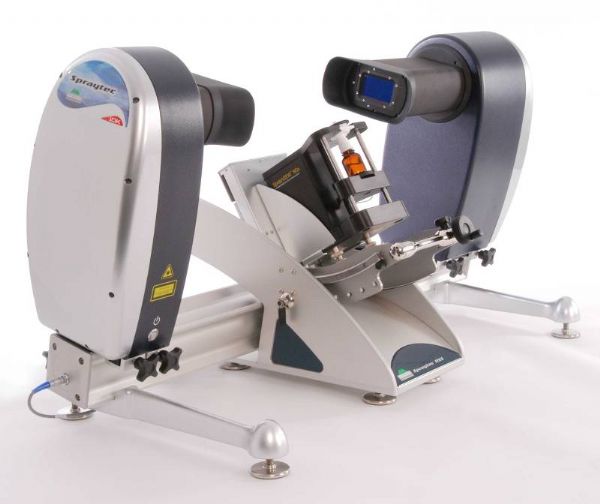
Figure 1. Malvern spray particle size analyzer for nasal spray particle size distribution
Benefits are valued by people, including the study of peptides and protein drugs. Among the many dosage forms, the spray is a relatively common dosage form, and the liquid is atomized and ejected only by the power generated by the atomizing device by means of compressed air. Since the spray does not contain a propellant, there is no need to use a pressure-resistant container, and the field of application is now more and more extensive. During the nasal spray study, it is important to have two factors that influence the size distribution of the nasal spray, namely the drug formulation and the spray device. You can find out how laser diffraction technology can reflect these influencing factors through the following simulation experiments.
First, a brief introduction to laser diffraction technology to measure a nasal spray. Figure 1 is a Malvern spray particle size analyzer. The devices erected at both ends are the transmitting end and the receiving end of the laser respectively. These devices can be freely moved to adjust the spatial position. The middle device is a trigger device for nasal spray, and is set as required. Different trigger pressures or trigger speeds (also useful for trigger time), and the spray angle can be adjusted so that the test parameters can be adjusted flexibly and quickly.
After the test is completed, the laser particle size analyzer will give the status of the entire injection process in real time. Figure 2 is a data of a nasal spray. The abscissa is time, the ordinate is particle size, and several different color curves represent D10, D50, D90 and the injection concentration as a function of injection time. The entire 0.16 second injection process can be divided into three stages, 0-0.02 seconds is the trigger stage, at which time the particle ejection is still unstable, the particle size is rapidly reduced, and the concentration is also rapidly reduced; 0.02-0.09 seconds is the stable stage, this The particle size distribution data tends to be stable; 0.09-0.16 seconds is the dissipation phase, at which time the particle size distribution becomes extremely unstable, and a large number of large particles appear. Laser diffraction technology not only gives a clear change process, but also gives the average particle size for the entire test process or for each stage. Figure 3 is a graph showing the average particle size distribution and particle size data for each stage.
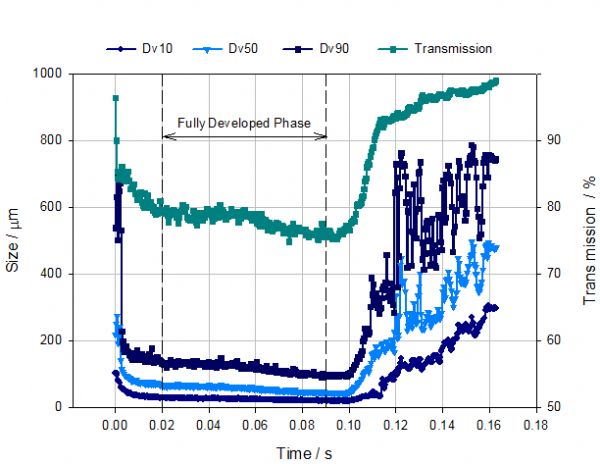
Figure 2. Nasal spray for a whole process

Figure 3. Separate particle size distribution and cumulative data for a three-stage nasal spray
It can also be seen from Fig. 3 that the average particle size in the initial stage is about 68 μm, and the particle size becomes smaller after stabilization to 37 μm, and the particle size in the dissipating stage is further increased to about 45 μm. And Figure 4 gives the injection data for 4 consecutive times, so
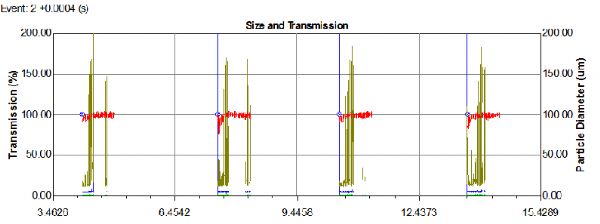
Figure 4. Spray data for 4 sprays of nasal spray
Not only can you see the particle size change and the average particle size of each pass, but you can also quickly and easily see the data changes and stability between different times. Figure 5 is a particle size data of a spray formulation designed for 50 cycles throughout the spray cycle. It can be seen from the data that, except for the first-order particle size, the data is still relatively stable up to 60 times, and 41 times of the time may be due to the failure of the operation to cause the spray particle size to become significantly larger. This method of operation provides a good data base for the spray cycle and stability of the nasal spray and tank design.

Figure 5. Particle size data for a nasal spray designed to be 50 æ¿ throughout the spray cycle
In addition to the stability of the shots, it is also possible to observe the effects of different formulations, different jet pumps and different jet sizes on the spray size. Figure 6 shows the droplet size of the same nasal spray formulation under different jet pump conditions.
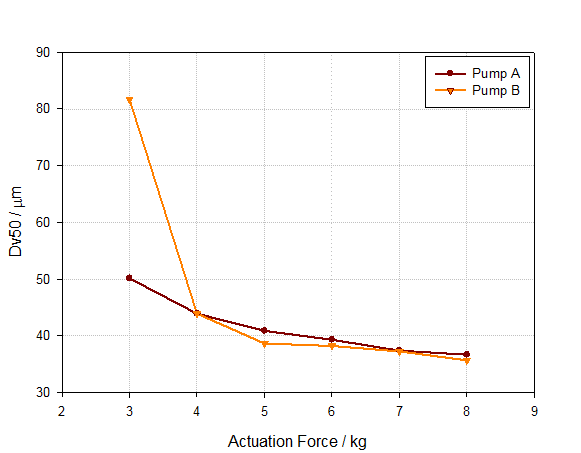
Figure 6. Effect of spray size on the same nasal spray formulation under two different pump conditions
It can be seen from the figure that the droplet size is significantly reduced with the increase of the trigger pressure of the two pumps, but in contrast, the B pump is not sensitive to pressure, while the A pump is at a lower pressure. As the pressure changes, the particle size will change greatly. These are the issues that must be considered when designing and selecting the pump.
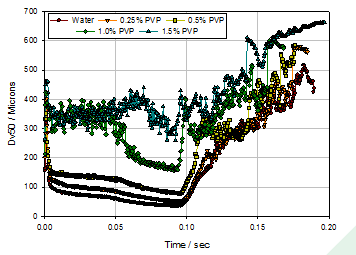
Figure 7. Effect of different concentrations of PVP on spray particle size (A pump)
Of course, the drug formulation also has a large effect on the particle size of the spray. The results can be observed through a simulation experiment. Under the same apparatus and the same pump speed conditions (40 mm/s), different concentrations of PVP aqueous solution were used to observe the atomization effect, and the PVP concentrations were 0, 0.25%, 0.5%, 1.0%, and 1.5%, respectively. Figure 7 shows the spray median particle size results for the five formulations. It can be seen that as the PVP concentration increases, the atomization particle size becomes larger and the atomization stabilization period becomes shorter and shorter, when PVP When the concentration reaches 1.5%, it is basically impossible to find a stable atomization state. The reason may be that as the concentration of PVP increases, the viscosity of the atomized liquid increases, resulting in atomized droplet size.
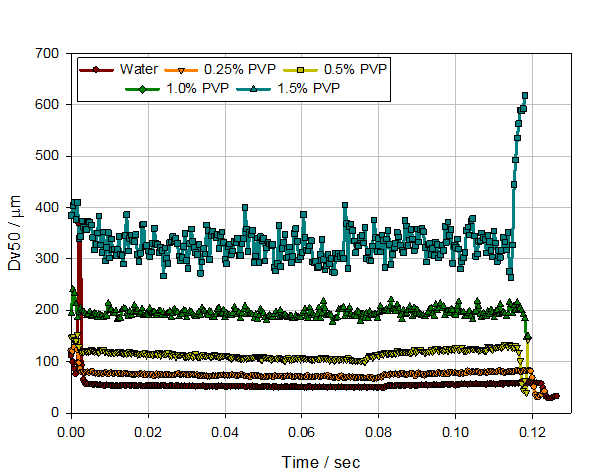
Figure 8. Effect of different concentrations of PVP on spray particle size (B pump)
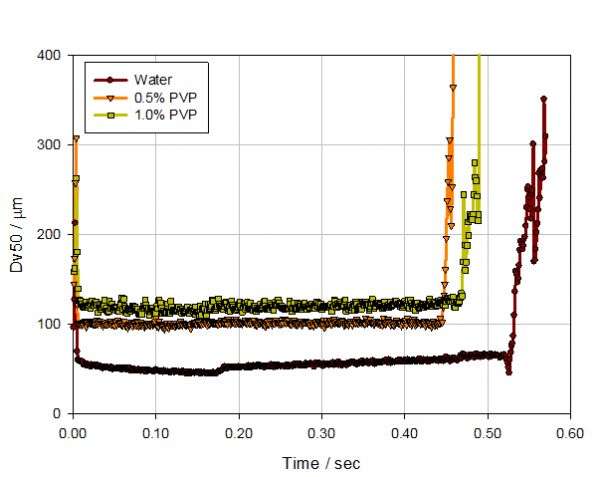
Figure 9. Experimental results for nozzles with smaller apertures (B pump)
Significantly larger, but for the same trend of the formula, we replaced the jet pump B, the results are shown in Figure 8. It can be seen from the figure that although the tendency of the particle size becomes larger as the PVP concentration increases, the spray stability increases significantly. This also shows that the shear force provided by the B pump completely overcomes the fluctuation caused by the increase in the viscosity of the atomized liquid. In order to further investigate the influencing factors affecting the spray particle size, a finer nozzle was observed to observe the atomization effect while maintaining the experimental conditions of FIG. Figure 9 shows the results of atomized particle size at finer nozzles for PVP concentrations of 0, 0.5%, and 1.0%. It can be found that the particle size distribution of the atomized liquid is significantly smaller, especially at the concentration of 1.0% PVP, and the atomic particle diameter of the atomized droplets is reduced from 200 μm to 120 μm.
3. Nebulizer spray
Spray refers to a dosage form in which a drug solution is driven by compressed air to achieve a dispersed drug through an orifice. Although it has a lot
Insufficient, such as large size, inconvenient to carry, complete atomization system is expensive, can only deliver one dose, etc., but its advantages are also obvious, such as no need for propellant, tank container without pressure, generally with water-based formula Fixed accessories, etc. At the same time, for drugs with higher inhalation doses (such as Novartis's 300mg tobramycin), spray atomization delivery also has obvious advantages. In addition, tidal breathing can be used. Currently, sprays are widely used in hospital emergency rooms, especially for children with asthma or chronic obstructive pulmonary disease and elderly patients. Sprays are also a type of formulation that places great emphasis on formulation and nebulization. In other words, only a good formula with a suitable atomization method can make a good spray. Of course, due to the different breathing patterns, it may also affect the particle size of the inhaled droplets. Therefore, the atomization formula, atomization method, and breathing mode must be considered during the research.
Figure 10 is a schematic illustration of a Malvern spray particle size analyzer test spray formulation. On both sides are the transmitting and receiving ends of the laser, and in the middle is a suction-type sample cell that simulates the human respiratory tract, while the white curved tube above is the USP artificial throat.
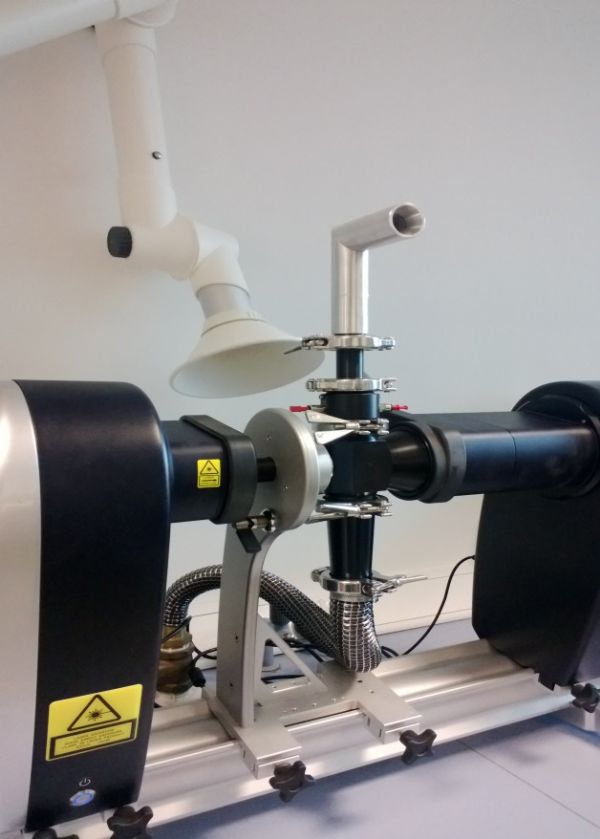
Figure 10. Malvern spray particle size analyzer test liquid mist schematic
Below the inhalation sample cell is a pump or a breathing device so that the liquid mist enters the laser test area through the upper artificial throat and is pumped away by inhaling the sample cell. Figure 11 is a particle size distribution of continuous liquid mist atomization. The abscissa is time and the ordinate is particle size. The curves of the three colors are D10, D50 and D90 of the droplet size. It can be seen that the particle size distribution of the droplets is relatively stable over an atomization time of up to 10 minutes. Various factors affecting the atomized particle size can be understood by the following experiments. There are many ways to atomize liquid mist, such as common spray atomization, vibration atomization or ultrasonic atomization. Each atomization has its own advantages and disadvantages. Among them, spray atomization is a common method. The main principle is that the liquid is carried through a narrow nozzle by a certain speed of compressed air. At this time, the flow rate of compressed air has a great influence on the atomization effect. . Figure 12 shows the same nozzle at different air flow rates
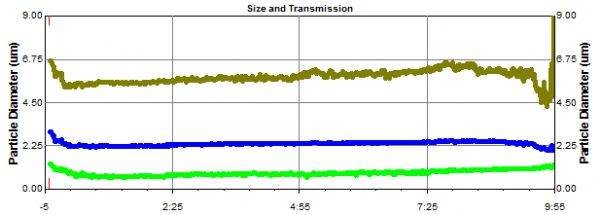
Figure 11. Continuous nebulizer atomization particle size test results
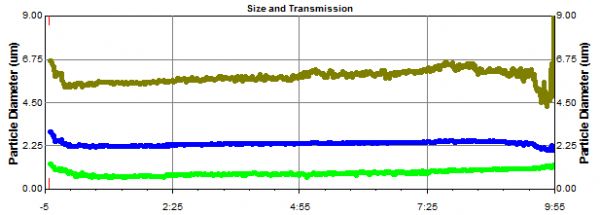
Figure 12. Effect of compressed air flow rate on atomized particle size
The atomized particle size results below. It can be seen from the figure that as the air flow rate increases, the particle size parameters D10, D50 and D90 of the atomized droplets decrease, and when the flow rate reaches 11 L/min, the atomized particle size reaches a minimum, followed by air. The flow rate is further increased, and the atomized particle size is rather large, which may be caused by a too large flow rate causing a portion of the large droplets to pass over the baffle.
At the same time, the Malvern spray particle size analyzer can be used in conjunction with a breathing simulator to conduct a more in-depth study of atomization. Figure 13 shows the atomization particle size of an atomization system in sinusoidal breathing mode. At the beginning, as the inhalation rate increases, the atomized droplet concentration increases rapidly and tends to be stable, while the atomized droplet size is rapidly Decrease and then slowly increase while inhaling
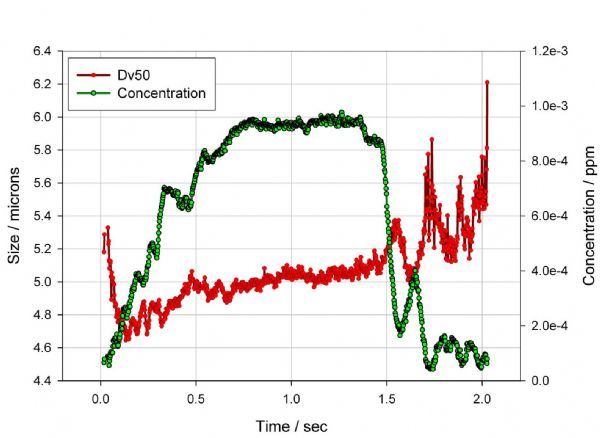
Figure 13. Atomization granularity results for an atomizing system in sinusoidal breathing mode
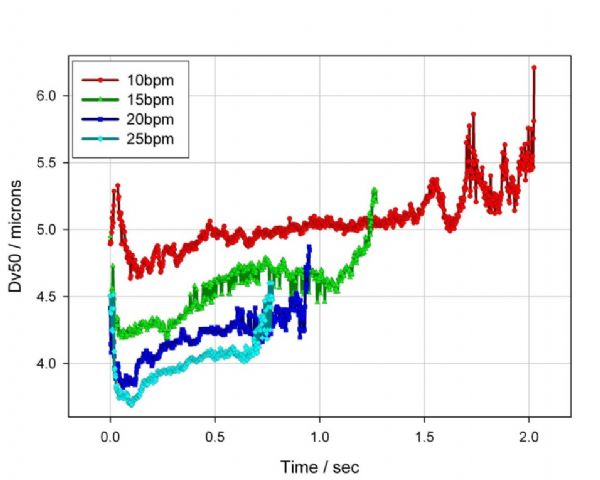
Figure 14. Atomized droplet size results at different respiratory frequencies
As the rate gradually decreases, the concentration of the atomized liquid rapidly decays and the particle size of the atomized liquid begins to increase significantly and is unstable. This data also exemplifies the changes that occur during the breathing process. Of course, you can also change the way you breathe, such as maintaining the same formula and tubing structure, increasing the respiratory rate, and observing the effect of breathing on the atomized particle size (Figure 14). It can be seen from the figure that as the respiratory rate increases, the inhalation time also decreases accordingly, and the flow rate of the inhaled droplets also increases, and the droplet size decreases remarkably.
In addition to the breathing mode, the formulation of the mist also has a significant effect on the atomization particle size. Figure 15 shows the atomization particle size results for three different concentrations of PVP solution. It can be seen that as the PVP is added and the concentration is increased, the atomized particle size is significantly increased, mainly because the addition of PVP increases the viscosity of the atomized liquid. At the same time, Figure 16 shows the above three kinds of atomization.
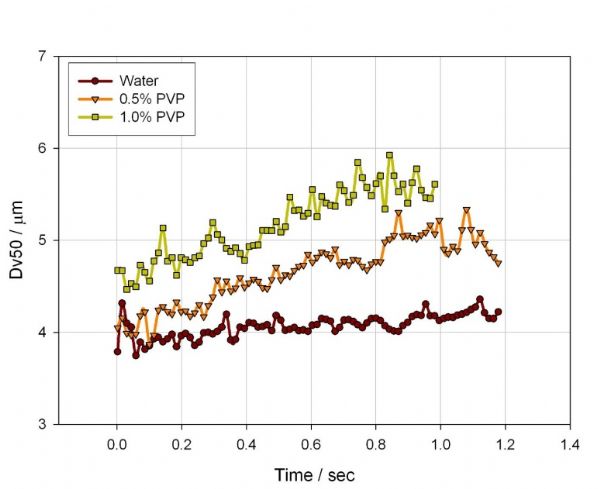
Figure 15. Atomized particle size results for different concentrations of PVP solution
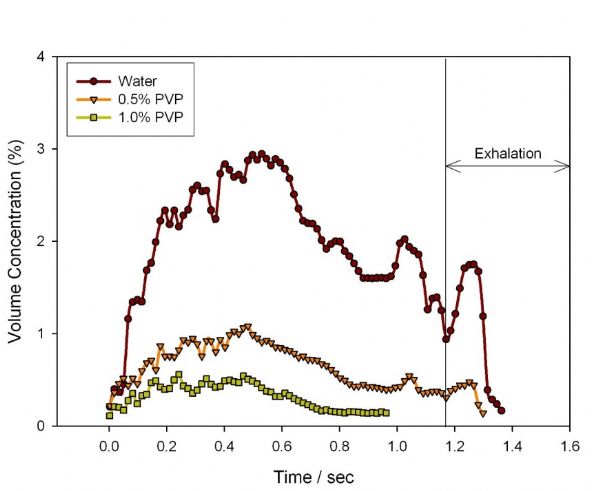
Figure 16. Results of aerosolized concentrations of different concentrations of PVP solution
The change in the concentration of the liquid inhaled during the inhalation of the liquid. As can be seen from the figure, as the PVP is added and the concentration is increased, the inhalation concentration is significantly reduced, which means that a higher viscosity atomizing solution may require a longer inhalation time in order to achieve the same delivered dose. .
4. DPI dry powder inhaler
Dry powder inhaler (DPI), also known as inhalation powder, is a new formulation developed on the basis of quantitative inhalation aerosol combined with powder delivery technology. It is a method of local or systemic administration, after the micronized medicine is mixed with the carrier alone or through a special drug delivery device through the active inhalation of the patient, so that the drug is dispersed into a mist into the respiratory tract. Dry powder inhalers have their own distinctive features: for example, there is no need for Freon propellant, there is no air pollution problem; no solvent, such as alcohol or preservative, which reduces the irritation to the throat and is also easier to preserve; it is not limited by the solubility of the drug. The dose that can be carried is higher; the solid dosage form is especially suitable for polypeptides and protein drugs. However, dry powder inhalers do not need to consider the problem of dissolution and suspension, but because of the easy agglomeration between the powder particles, the factors of coating or interaction between the active ingredient and the auxiliary carrier must also be considered in detail, which has more to the inhalation device. High requirements, which means that it must be a suitable active ingredient and carrier, control the appropriate particle size, and with a suitable inhalation device, in order to achieve a stable and safe dose delivery.
To further illustrate this problem, a different inhalation device was used to observe the atomization effect by two different drugs. Two of the powder drugs were salbutamol and budesonide, and Table 1 shows the proportion of atomized fine particles. It can be seen that the dispersion effect of the same material in different inhalation devices is very different, such as the fine particle ratio of budesonide.
Table 1. Fine particle ratio of two powders under different inhalation devices
Can be changed from 14% to 63%. However, if the molecular surface energy of budesonide is more than five times that of salbutamol from the viewpoint of powder physical properties, it means that the particles of dispersed budesonide are much more difficult than that of salbutamol. But seeing the end result, on the contrary, the budesonide powder has more fine particles dispersed, which further indicates that the powder inhalation dispersion is not simply carried out according to the laws of its physical properties, so if a dry powder inhalation preparation is to be carried out For research and development, it is necessary to consider the powder formulation and the inhalation device at the same time.
Next, a small experiment was conducted to see how the powder formulation process, inhalation device, and inhalation rate affect the atomization effect. Three kinds of powders were selected (see Table 2). The first one is ordinary micronized lactose powder, the second is micronized lactose added with 5% MgSt, and processed by laboratory common mixing equipment. Three of the same micronized lactose were added with 5% MgSt, but a high-intensity mixing device was used (this technique was developed by Vectura). Since magnesium stearate itself acts as an amphoteric substance, it can form a coating structure on micronized lactose, thereby reducing the agglomeration of lactose, but at the same time the mixing mode and efficiency will greatly affect the efficiency and uniformity of lactose encapsulation. It also directly leads to the complexity of powder delivery. Figure 17 shows the particle size distribution of pure micronized lactose at different inhalation rates. It can be seen from the figure that as the inhalation rate increases, the particle size of the particles decreases significantly, indicating that although the lactose itself is relatively small. of. However, since the fine particles have a strong agglomeration effect, as the inhalation rate increases, the shearing force increases, resulting in smaller and smaller particles, but the agglomeration is still obvious. Figure 18 shows the ordinary mixed lactose + magnesium stearate powder in different suctions
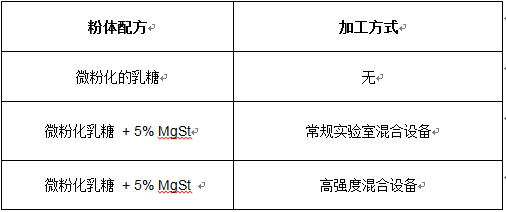
Table 2. Powders of three different formulations and processing techniques

Figure 17. Particle size distribution of pure micronized lactose at different inhalation rates
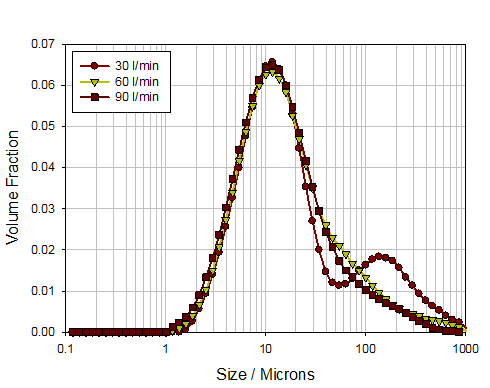
Figure 18. Particle size distribution of commonly mixed lactose + magnesium stearate powder at different inhalation rates
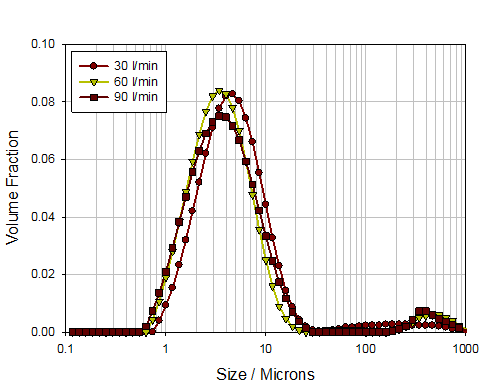
Figure 19. Particle size distribution of high-energy mixed lactose + magnesium stearate powder at different inhalation rates
The particle size at the rate of entry. Compared with pure lactose, the particle size of the particles is firstly reduced at a low inhalation rate, especially in the case of large particles, indicating that the encapsulation of magnesium stearate reduces lactose agglomeration to a certain extent. However, as the inhalation rate increases, the particle size changes are not obvious, and the agglomeration is still very obvious, which indicates that the magnesium stearate is not uniformly packaged, in other words, it does not form a wrap on the surface of a single lactose particle, but multiple The lactose agglomerated particles are encapsulated. Thus, these large encapsulated particles do not disperse as the inhalation rate increases, thus causing the particle size to be larger at the high flow rate than the pure lactose. However, if the processing method is improved, the dispersion uniformity and the encapsulation efficiency of magnesium stearate are improved, and the encapsulation of the individual lactose particles is achieved, the dispersed particle size can be greatly improved. Figure 19 shows the particle size of the powder in a high-energy mixing mode under different inhalation conditions. It can be seen that the dispersed particle size is greatly reduced, basically below 20 microns, and its particle size distribution is not for the inhalation rate. Sensitive, all of which indicate a significant increase in the efficiency and uniformity of lactose encapsulation.
5. Laser Diffraction & Impactor Connection

Figure 20. Laser Diffraction Particle Size Analyzer and Anderson Impactor Connection
In order to make the measurement conditions of laser diffraction consistent with the test conditions of the collision method, the laser particle size analyzer can also be connected with the relevant collider. Figure 20 is a schematic illustration of the Malvern spray particle size analyzer coupled to the Anderson striker, wherein the inhalation formulation enters the inhalation sample cell through the upper artificial throat for particle size detection and then enters the impactor through the lower interface. Since the matching of test conditions is greatly improved in the same path, laser diffraction as a non-destructive testing technology itself does not have any influence on droplets and droplets in the path, thus greatly expanding its applicability.
6. Summary
Nowadays, inhalation preparations are getting more and more attention from everyone. Whether it is aerosol, liquid mist or powder mist, no matter what form, particle size detection is undoubtedly an indispensable part of in vitro testing. The current process of pharmaceutical R&D is actually a process of racing against time, so how to quickly screen and screen a large number of recipes, spray devices and test conditions during development is critical. The laser diffraction technology has the characteristics of fast and non-destructive, and the result is very strong. It can quickly provide a large number of data related to particle size detection, providing a solid guarantee for the development and production of inhalation preparations.
FEATURE:
- Cookie Press Icing Set
- Better idea for kids
- Easy to clean
- Safety food grade stainless steel material
How to use:
Wash your hand and it dry. when the dough is ready,you can use Cookie Cutter to cut biscuits out,you can make any pattern you want easily by using cookie cutter ,then you can put them on tray and into oven.
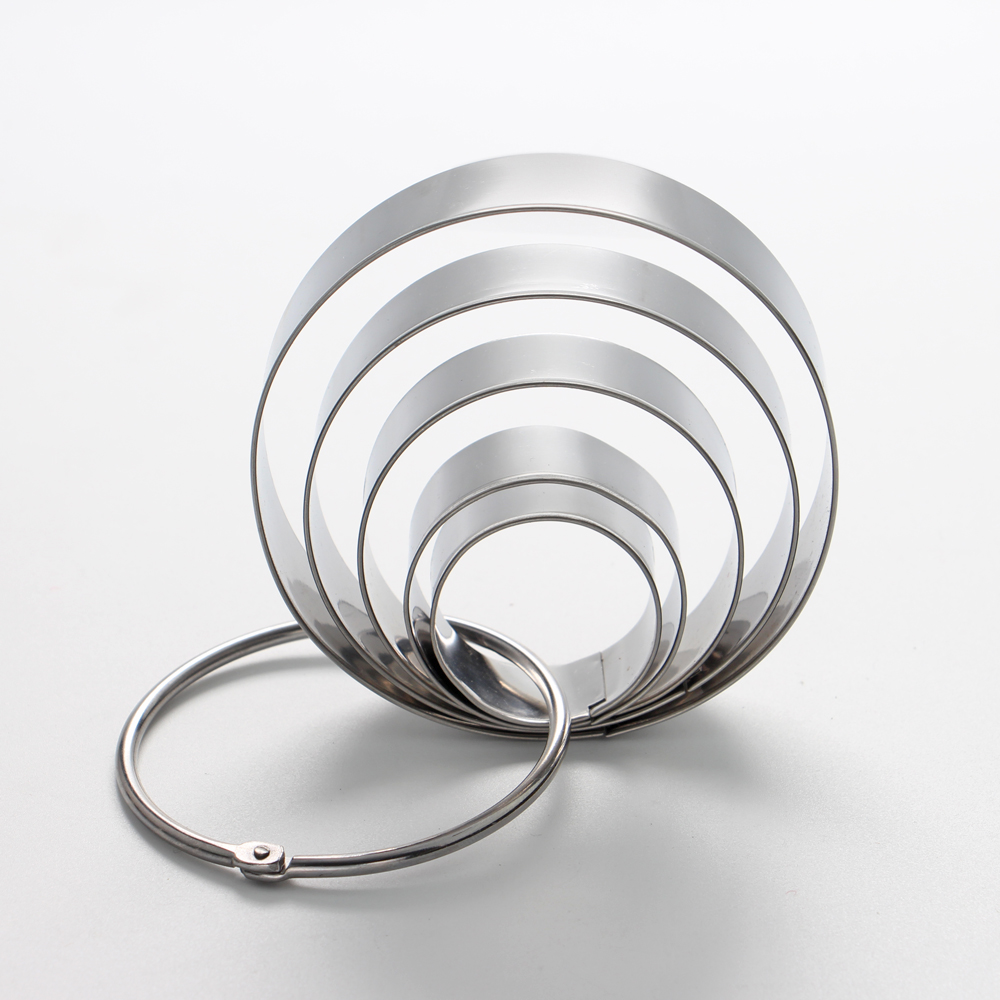

Stainless Cookie Cutters,6 Inch Round Cake Cutter,Stainless Sandwich Cutters,Stainless Steel Biscuit Cutter
YANGJIANG SHENGHAI INDUSTRIAL&TRADING CO., LTD , https://www.shenghaiyjs.com